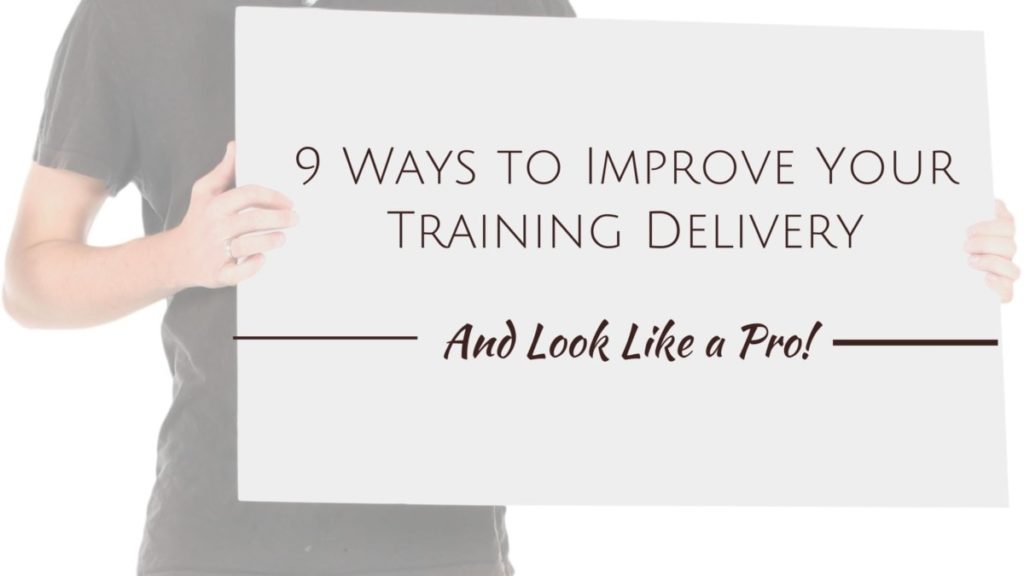You\’ve just been asked to deliver a training session. The only problem is, you\’ve never really done that before. Or, maybe you just got hired into a training gig and aren\’t sure where to start.
Certainly, you will want to get familiar with the content of whatever you are training. In addition, there are several things you can do to make sure your delivery of the training is top notch.
In this article, I\’ll share nine ways you can improve your training delivery and build your confidence regardless of experience level.
Brush up on the basics
One of the first things to get yourself up to speed on are basic platform/presentation skills. If it\’s your first time running a training class, you may want to take some kind of presentation skills class.
The skills you will need to focus on will depend on whether the class is being held onsite or online.
Top basic skills for either will include vocal tone/variety, facial expressions (assuming you are on camera for any part of an online session) and the ability to be flexible with your content.
The in person classroom adds a few more such as overall body language, movement, gestures and eye contact.
Know Your Audience
Who are the learners in your audience? Are they all in the same department or job role? Are they hourly employees? Salaried? Are they company leaders? How familiar are they with the training topic?
You want to know all of this before you go into the training session. The make up of the audience has a huge impact on how you will want to approach your training session.
For example, if you are training a group of executives, you need to think about how you are going to quickly get to the main points. An audience like this typically has little patience for a long, drawn out training session.
On the other hand, a group of new employees just joining the company are probably up for a bit of fun. You can be a little less formal with this type of audience.
Similarly, knowing what the audience knows about your topic is also going to help you deliver a more effective training session. Is there material you can remove because it is something they already know or doesn\’t pertain to them? Or, do you need to add something extra because the knowledge level is low on that particular topic?
Make sure you know all about your trainees well before the class starts.
Room Reconnaissance
In some instances, you will have already taught in a particular room or with a particular meeting software (e.g. Zoom) before. If it is your first time with either, though, it is a good idea to check it out before you start training.
For an in person, classroom training, I always like to look at the room set up at least a day before. I want to see the layout and how much space I am going to have. I don\’t want to be surprised on the morning of.
You may or may not have access to the room prior to the day of the class. If you don\’t, then it\’s important to get there early to make sure everything is set up the way you want it.
In the case of an online class, I\’d do the same with the meeting software. Make sure you know how to see if someone has a question or has posted into the chat. You don\’t want to waste valuable time trying to figure that out in the middle of the session. Set up a practice meeting and get familiar with all of the functionality beforehand.
Step Away from the Podium
This will only apply to an in person classroom session.
Many training rooms will have a podium or lectern at the front of the room. This can be useful for placing notes or a laptop. Unfortunately, it can also be used as a crutch for inexperienced presenters and trainers. They stand behind it and never come out. It may feel more safe to hide behind the podium but it does not help with making a connection to your audience.
It\’s ok to start out at the front, as you are looking over notes or beginning the presentation from your laptop. Make it a point to step away and in front of the podium at some point, though. You want to use the classroom space. This helps to hold interest as well as to connect more with your learners.
Prepare for Questions
Have you ever been to a presentation and the person used up so much time talking that they ran out of time for questions? Don\’t be that person.
In an employee training session, you should not be the only one talking the whole time. There should be a good amount of dialogue/back and forth between you and the learners. Questions and answers should be a part of this.
To help you anticipate the types of questions you will get, be sure to put yourself in the learner\’s shoes. What types of questions are they likely to ask?
It can be very helpful to make a list of the questions you think are likely for the topic you are training on. By doing so, you can build some of the answers into your delivery. It also helps because you may realize there are some you don\’t know off the top of your head. Knowing that, you can make sure to look them up or have a resource readily available to use.
Of course, you won\’t be able to foresee ALL of the questions you get. Be prepared for that as well. Set up a \”parking lot\” where you can write down any questions you don\’t know the answer to but will find out for them.
This is also a good place to put questions that come up which are off topic when they are asked but will be covered in a different section of the training.
Build Rapport
If you think about some of the worst training presentations you\’ve been to, you probably realize one of the main reasons they were bad was because the trainer made no effort to connect with or build any kind of rapport with their audience.
Many trainers and presenters get very caught up with what they want to say and don\’t think about the people they are saying it to.
There are many opportunities for you to connect with your audience beginning with when they first enter the room (both physically and virtually). Greeting people as they enter is an easy way to start connecting.
Asking them questions as well as any general conversation can also be a great way to start winning the audience over to your side. Once the training starts, you can refer back to these conversations as appropriate.
Stories and humor are some other ways to keep up rapport with your audience. Of course, what types of stories and humor will depend on the audience. Remember: know your audience!
Look for ways to engage and involve the audience throughout. You can do this with questions that you ask them. You can also give them opportunities to share their own experiences with the topic.
PowerPoint Should support and Enhance
I mentioned the podium as a crutch for in person training. An even worse crutch that applies to both in person and online is the PowerPoint.
PowerPoint in and of itself is not bad. It is a great tool that is used poorly by a lot of people. Thus, it gets a bad rap.
New presenters often view PowerPoint as a sort of cue card. They throw all of their speaking points on the slides and then read off of those slides. That is not the intent of PowerPoint.
Your speaking notes should be separate from the PowerPoint. You should only have a minimal amount of information on the slide. Ideally it should be mostly visual – an image that relates to what you are talking about with some supporting text if necessary.
You want your audience to be looking at you and focusing on what you are saying. Not trying to squint and read a bunch of text up on the slide.
Spotlight your learners
New presenters and trainers often think of themselves as the \”star of the show\”. While you are an important piece of the overall training experience, the real \”stars\” should be your learners.
The success of your training session isn\’t how many times you impressed the audience or made them laugh. Yes, you want to be engaging. The true measure of success, though, is what your learners are able to do as a result of the training.
Just like you did with building rapport, look for opportunities to shine the spotlight on your audience. Give them a chance to demonstrate their retention of the material and how they are going to use it in their jobs.
Practice, Practice, Practice
Whenever I think back to presentations I\’ve given that have flopped, they all have one thing in common: lack of practice. I have at times, unfortunately, fallen into the trap of thinking I was experienced enough to not need to practice. This is false thinking.
It doesn\’t matter how long you\’ve been training. Any time you are about to train a new topic or course, you should do some kind of practice.
Ideally, you would run through it in the space that you will be doing the training whether that\’s a training room or in your office (if the training will be virtual). Anywhere is fine, though, as long as you take some time to go through your content and speaking points.
When I practice, I like to actually stand up and go through all of the motions. It really helps when I do the real thing because, if I do it enough, my muscle memory will kick in and help it all feel comfortable.
Of course, there is a bit of a fine line as far as sounding TOO rehearsed. This isn\’t a speech. With training, you have to allow for spontaneity and learner interaction as I\’ve mentioned.
You want to come off as polished and professional without sounding scripted.


Pingback: Five Must Read Books for Corporate Trainers – Your Learning Career
I am looking forward to helping my nursing students study for exams with Jeopardy
The material found here will be very helpful for my upcoming train the trainer program.
Thanks